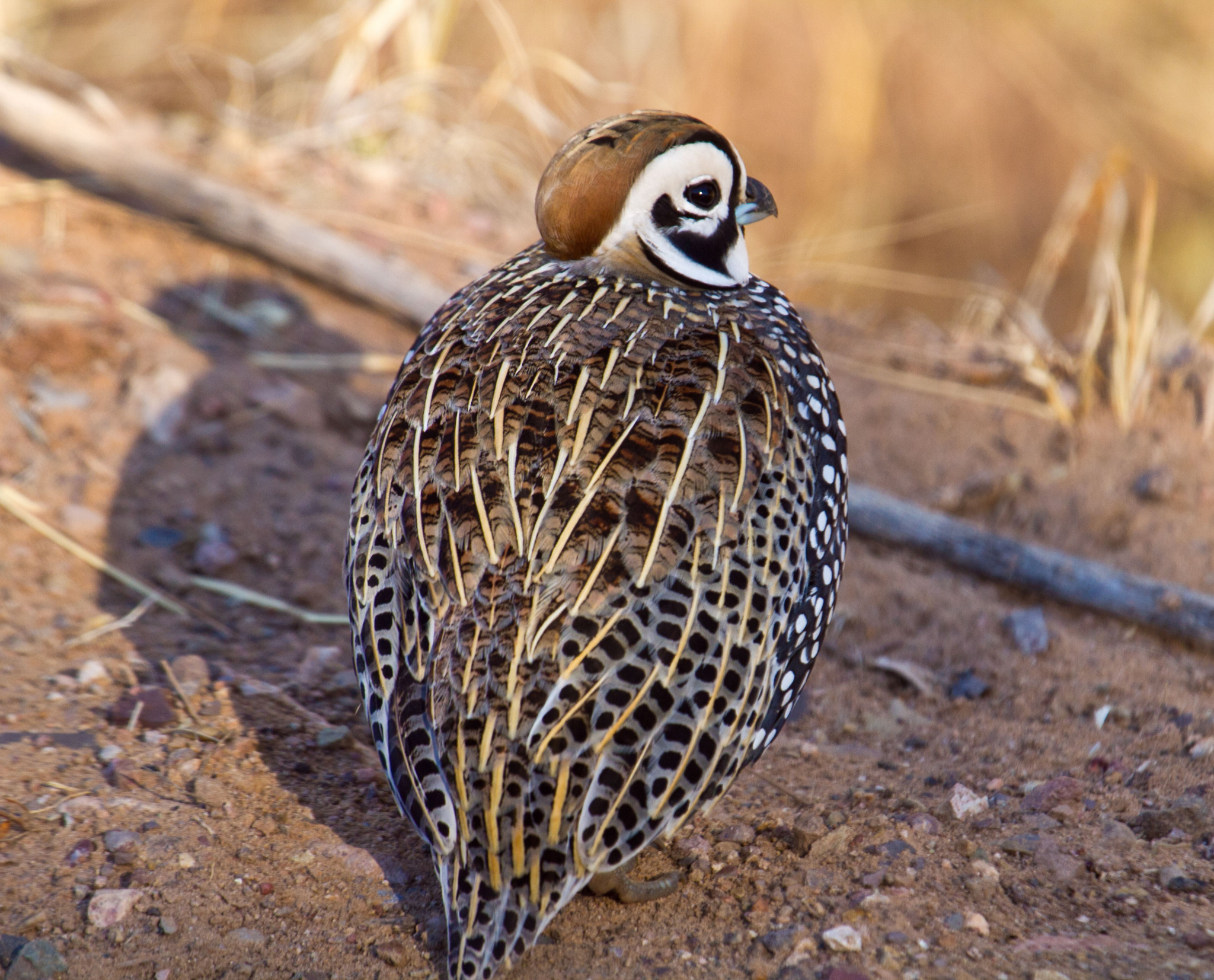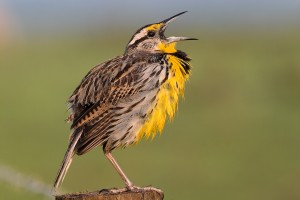 Size: 12 square miles, 7723 acres
Size: 12 square miles, 7723 acres
6028°N: 110.5217°W
County: Santa Cruz
Identified: 01/2004
Criteria: State: Species of Conservation Concern
State: Species in rare/unique habitat (Grassland Birds)
Visiting the IBA: Visitors are asked to e-mail researchranch@audubon.org or call 520-455-5522 before scheduling a trip. This IBA is located south of the town of Elgin. The miles before the ranch are not paved but are in good condition.
Ownership: National Audubon Society, Swift Land and Cattle, Coronado National Forest, Bureau of Land Management. The BLM lands are a part of the Las Cienegas National Conservation Area
Site Description: The Appleton-Whittell Research Ranch of the National Audubon Society is located in broad semi-desert grassland in Southeastern Arizona. It is a 13 square mile sanctuary from which livestock has been excluded since 1968. It encompasses a mix of habitats including semi-desert uplands, oak savannahs, oak woodlands cut by small ephemeral creeks, with riparian habitat. he AWRR is primarily a sanctuary and a research site.
Birds: Species of special conservation status and interest that use the habitats within this IBA include:
Breeding: Scaled Quail, Montezuma Quail, American Kestrel, Burrowing Owl, Gray Flycatcher, Horned Lark, Eastern Bluebird, Cordilleran Flycatcher, Western Kingbird, Cassin’s Kingbird, Lucy’s Warbler, Virginia’s Warbler, Black-throated Gray Warbler, Blue Grosbeak, Botteri’s Sparrow (wintering), Cassin’s Sparrow, Grasshopper Sparrow, Chipping Sparrow, Lark Sparrow, Rufous-crowned Sparrow, and Eastern Meadowlark (Lillian’s).
Migration and Winter: Band-tailed Pigeon, Northern Harrier, Swainson’s Hawk, Yellow-billed Cuckoo, Willow Flycatcher, MacGillivray’s Warbler, Black-chinned Sparrow, Baird’s Sparrow, Vesper Sparrow, Brewer’s Sparrow, Sage Sparrow, Savannah Sparrow and Sprague’s Pipit
Conservation Concerns: Grassland habitat health requires management of grazing, off highway vehicle travel and fire. Loss of grasslands impacts the Pronghorn Antelope population and the grassland bird assemblage. Immediate concerns are: invasion of exotic grass species (Lehman and Boer lovegrasses, Johnson grass and Bermuda), wild fire, Strategies: Entire site is a protected area. The BLM property is part of the Las Cienegas National Conservation Area and the Forest Service portion is designated a Research Natural Area. All roads except the main access road are designated administrative only. Prescription fire and control of invasive plants and animals (grasses, blackberry and bullfrogs)
Conservation Stewards: Audubon Arizona and The Research Ranch Foundation
Maps of this Important Bird Area:

Mini Conservation Plan
Arizona Game and Fish Department Conservation Opportunity Area
Web Page for Appleton-Whittell Research Ranch
Complete eBird.org Checklist of birds Reported for Appleton-Whittell Research Ranch of the NAS IBA

| Vegetation Description | Acres |
| Semiarid/Sonoran Savannah Grasslands | 3,801 |
| Chihuahuan Desert Scrub
Evergreen Woodland |
2,868
744 |
Ornithological Summary:
Grassland Winter and Fall Passasge Species of Conservation Concern: Baird’s Sparrow, Black-chinned Sparrow, Brewer’s Sparrow, and Sage Sparrow, (Passage Period-Fall): Sprague’s Pipit (plus grassland obligates: Northern Harrier, Vesper Sparrow, Savannah Sparrow). 1 SCS (Passage Period-Fall):200
The Appleton-Whittell Research Ranch is 8000 acres of contiguous grassland that has remained ungrazed for 35 years. It is part of the last remaining viable short-grass prairie between Texas and the Pacific coast. It supports 22 species of conservation concern; the majority of which are grassland obligate species.
Grasslands have been designated priority habitat by the Arizona Partners in Flight (APIF) Conservation Plan and of the six species listed by APIF as Priority species for Desert Grasslands, this IBA contains four species (Botteri’s Sparrow-breeding, Baird’s Sparrow-wintering, Cassin’s Sparrow-breeding, and Grasshopper Sparrow-resident). Regarding the other priority species, the Aplomado Falcon needs elevated nesting platforms and/or tall Yucca, and the Rufous-winged Sparrow prefers a partial shrub canopy, and occurs primarily below 1000 m). Other grassland species of special conservation status include Montezuma Quail (resident), Black-chinned Sparrow (wintering), Brewer’s Sparrow (wintering), and Sprague’s Pipit (fall migrant)- and Sage Sparrow (wintering), Eastern Bluebird (resident), Burrowing Owl (resident)-all APIF Priority species, and Northern Harrier (wintering) a USFWS Bird of Conservation Concern (within BCR 16). Other grassland obligate species are abundant on the research ranch, i.e., breeding: Horned Lark and Chihuahuan Meadowlark, and wintering: Vesper Sparrow and Savannah Sparrow.
Other non-grassland species of special conservation status include Band-tailed Pigeon (fall migrant), Willow Flycatcher (summer visitor), Lucy’s Warbler (breeding), Virginia’s Warbler (breeding), Yellow-billed Cuckoo (summer visitor), Black-throated Gray Warbler (breeding), Cordilleran Flycatcher (breeding), Gray Flycatcher (breeding), and MacGillivray’s Warbler (fall migrant) (all APIF Priority species).
Conservation Issues: A major threat to this Madrean grassland IBA is the invasion of exotic grass species (Lehman and Boer lovegrasses, Johnson grass and Bermuda), which has resulted in a change in grassland composition and thus habitat quality for native bird populations and other wildlife species. These grasses were brought by human settlers, and have spread by cattle, wind and water. Although there has been no grazing by domestic herbivores on the Appleton-Whittell Research Ranch for 35 years, the changes on the surrounding habitat in the Sonoita valley is likely to have reduced overall populations of native grassland-dependent species. Invasive grasses removal is being addressed on the Appleton-Whittell Research Ranch by Audubon staff through intensive species-specific efforts, so as to protect native species. One project underway is transplantation of sacaton (Sporobolus wrightii) into areas where Bermuda grass dominates the riparian floodplain.
A second major threat to this IBA is the alteration of the natural fire regime by past and current fire suppression management decisions. Encroaching and rapidly expanding human inhabitation of the Sonoita valley with homes and other development throughout this once vast grassland community has required fire suppression decisions based on human safety concerns and private property protection. This has reduced range-wide fires and has resulted in shrub encroachment, which has reduced open-range grassland habitat, and altered the soil dynamics (i.e., the enrichment of soils following fires, resulting in an increase in available nutrients for plants). Fire ecology needs are being addressed through a controlled burns program.
“Island Biogeographic” influences to bird populations within the Appleton-Whittell Research Ranch are also likely to increase with increasing development, such as decreased dispersal capabilities of resident bird populations into and from the IBA. Lastly, human impacts to the habitats are a threat, e.g., illegal hunting and/or off-road vehicle trespassing. Fence repair as well as posting and patrolling the area are steps being taken to address this issue.









